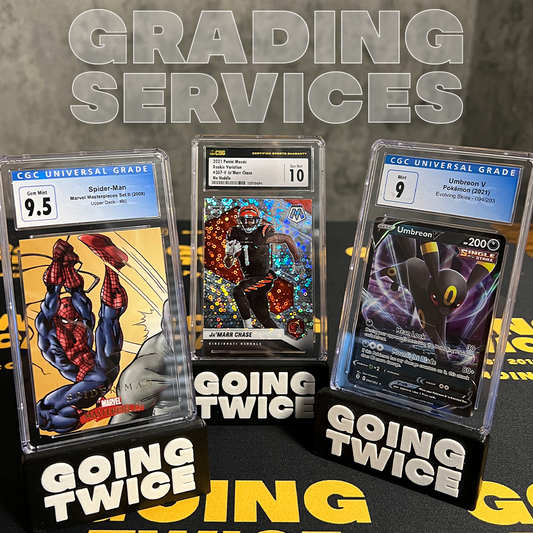Graded cards have become the anchor for many collectors, taking precedence over “raw” singles when it comes to buying cards to add to a collection. Buying graded cards has the advantage of guaranteeing the authenticity of whatever collectible is being purchased as well as giving the buyer an exact assessment of the condition the card is in. Sometimes even raw cards that have great eye appeal at first glance have small scratches or indents that would only be spotted under the right lighting and by a keen eye. The hope is that by purchasing a graded card, a professional has done the assessment for you, and you can be confident that the condition the card was given in the form of a grade is accurate.
So, you wanna grade some cards?
With all this in mind, it’s obvious why so many people who may have never graded a card in their life are suddenly sending out hundreds at a time. However, not everyone knows what to send, how to send, or what questions need to be asked before cards are sent out to grade. I am going to break things down into a simple process by which you can fairly quickly decide what cards will be worth the time, effort, and money to be graded.
What is the purpose of grading this particular card?First things first, are you grading this card to be added to your personal collection, or are you hoping to make a buck selling it once your submission returns? If the card is for you, and you want to simply authenticate and protect it against the ravages of time, then the grade it receives is less important and the decision to send it to get graded is an easy one if you have the available cash on hand to pay for it. However, things get more complicated if you believe you will be making money by submitting this card or cards and more questions need to be asked.
What is the turnaround time for my submission/is it worth paying more money per card to get them back faster?
So you’ve decided your cards are worth more slabbed up and you are going to make it happen. Well before you send everything out, take a moment to consider what grading company you are sending to and what their turnaround times look like. Understand that while the company’s website may say 60-90 days for economy submissions, that may not be accurate. It is much better to ask other collectors you know who may submit cards on a more regular basis what their recent experiences have been to get a more accurate idea of how long you will have to wait before you see your precious cards again. You can also search message boards and Facebook groups for feedback about recent submission experiences if you don't know anyone personally who sends a lot of cards to be graded. Turnaround times matter because if you are hoping to sell your cards once they return, timing can be everything. Sports cards in particular can be very fickle, as players get injured, get traded, retire, etc, so knowing where the market is going to be is very important. For Pokemon, modern sets can be tricky, as more and more cards hit the market, prices can drop almost in half if you aren't one of the first sellers to bring a new card to market. This isn't meant to dissuade against grading modern cards, but just to remind anyone looking to grade cards to consider these things when deciding what cards to send, and whether that extra money is worth spending to get your big hit graded in 3 weeks as opposed to 3 months.
Do you need to get a 10 for this card to be worth the grading fee?
This one is crucial. Particularly nowadays, the difference in price between a 9 and a 10 can be monumental. This isn't to say there aren't cards worth a lot of money in almost any grade, but it is very important to do some research before sending a card out to be graded. For example, if the card you have sells for around $150 in a ten, but if it receives a 9 that drops to $30, are you willing to take that risk if it costs $30 to grade the card in the first place. Many people are willing, but you need to be ready for the reality that you may not get the 10 you think is deserved. Understand if this is your first time sending cards out to be graded, you may have missed small imperfections on what you consider to be a perfect card. Many cards are still worth quite a lot graded in a mint 9, but that’s where your own research is important so you can identify which cards can still make you money if you fall short of the pristine 10 grade. Keep in mind that even the smallest indent on a card will automatically bring its grade down to a 6 at most companies, no matter how perfect the rest of the card is, so it's very important to examine your cards in a well lit area and from multiple angles. Hope for the best but plan for the worst is the best mentality, as grading is not cheap and certainly takes quite a bit of time between examining the cards and packaging them up with the appropriate submission forms.
Pack your cards carefully or you’re probably screwed
Having done all your careful examinations, dedicated research about pricing, and have decided which grading company meets your needs, now it’s time to pack your cards to be sent off. This step is as important as your selection of cards to grade, because if your cards are damaged en route or in the company’s warehouse as they wait to be graded, there goes your careful selections as most or all of them just got downgraded to 4’s. First, always put your cards in card savers NOT toploaders when they are being sent out for grading. While toploaders are wonderful for keeping cards safe when they are hanging out in your personal collection, it is more difficult to pull a card safely out of a toploader than a card saver. Graders at the large companies are looking at hundreds if not thousands of cards per day, and the last thing they want to do is spend a minute wrestling your card out of its top loader while trying not to get any fingerprints or indents on the surface. Card savers are much more grader friendly and ensure your sleeved card can be removed with no fuss.
Once you’ve put all the cards into card savers, now it's time to pack them up into the box you will be shipping out in. This is where a bit of paranoia can come in handy, as overdoing it with the bubble wrap can actually be a good thing. Obviously you don't need to wrap your cards half a foot deep, but it’s advised to have at least 2 inches of padding between your cards and the sides, top and bottom of your box. CGC has a packing kit that you can buy which provides you with a robust cardboard box with dividers that makes packing the cards a breeze, but a regular box will do just fine as long as you pad it adequately. Make sure you include the submission form provided by whatever grading company you are sending the cards to inside the box on top of your bubble wrapped cards so whoever opens you box can quickly find it. With all that done, close up your box and send it out!
I hope this article has been helpful, and the more you grade and receive cards back, the easier it becomes to quickly identify what cards are suitable and which ones wont grade well or simply aren't worth the risk. Any whitening on the edges will detract heavily, surface marks or creases are a death sentence, and how well centered the image on the card is will play a role, though how significant it is will depend on the grading company and the grader. If you have cards that are already graded, take a close look at them to give you a benchmark of what certain number grades look like translated to an actual card. There’s no foolproof way to know what grades you will receive and people who have submitted cards for years won't say they are accurate in their predictions all the time, but you will gain a much better idea the more experience you get and the more cards you look at. Good luck on your journey, and may the grading gods be on your side.
Grading with Going Twice
Did you know that Going Twice offers grading services with CGC? Check out our Grading Services for more information on how we can assist you with your grading, both Sports and TCG.




